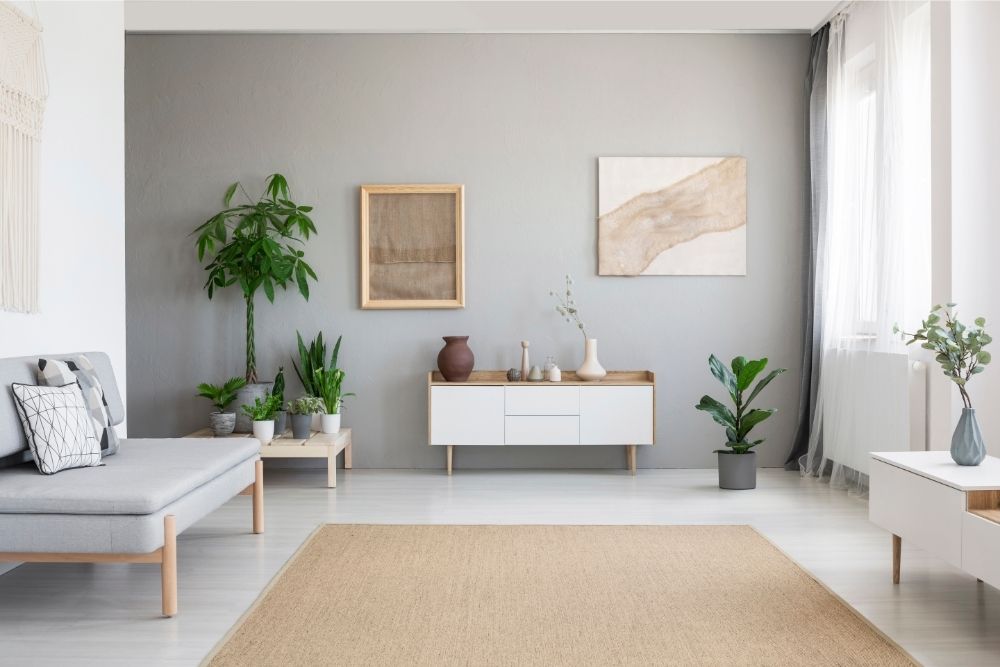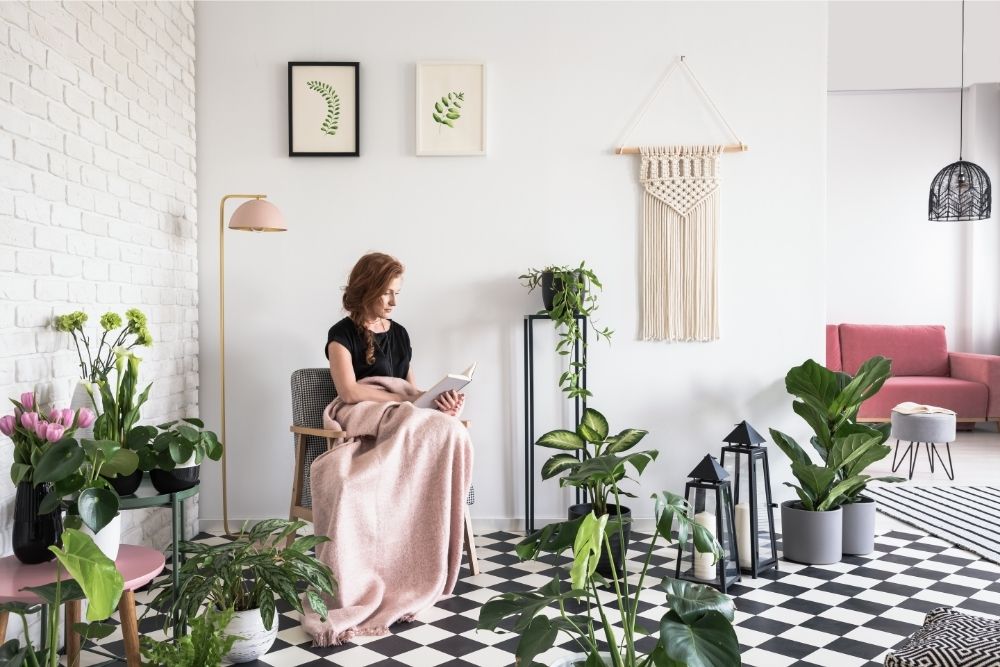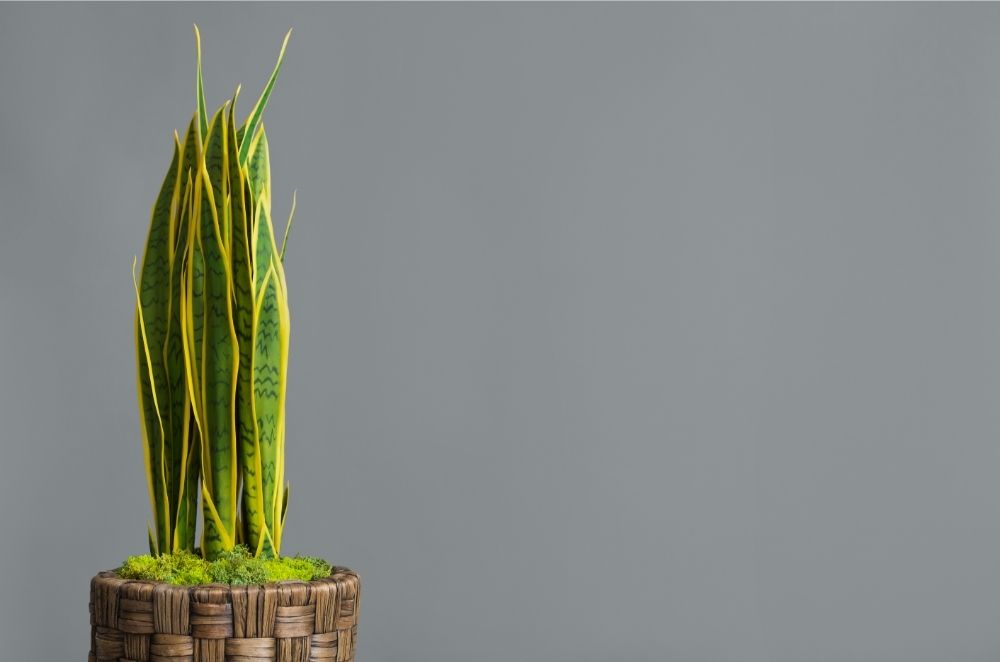- Floor Plant: Are These Big Beauties Worth the Space?
- Greg Poblete
- May 12, 2021
- 9:31 pm
- No Comments
Floor plants have become a household essential. Whether you live in a studio apartment or a cozy home, a floor plant can instantly spruce up your living situation quite nicely. For some, floor plants have become a higher priority to buy for your living room than a sofa!
Maybe you are already own a few potted plants or are new to the floor plant game. No matter how green your thumb is, this article will help familiarize you with everything you need to know about floor plants. We will discuss what exactly floor plants are, how much maintenance they require, what types of pots are best suited for them, and some of the most popular floor plants you can find!
What Are Floor Plants?
Floor plants may make you think of moss-covered ground or small indoor trees, and they are simply any plant you can place on the floor. This is typically done with a floor planter or an elevated pot. Floor plants usually fall into one of two categories: indoor trees and large accent plants. These floor plants can be an excellent accent piece in any room they are placed in. They provide color, a natural flair, and a serene atmosphere.
Indoor trees are larger plants that invite plenty of attention and magically transform a smaller room into a space that feels larger. If you are in desperate need of some new room decor or you are tired of cluttering your wall with art prints and photos, an indoor tree is the route to go.
Some fantastic indoor trees you can pick up are a Calathea Rattlesnake, a Norfolk Island Pine, or a weeping fig. Large accent plants range in their colors, textures, and sizes; there’s truly an option for everyone. You can place these kinds of plants on top of an end table, a raised pot, or even on a shelf. Large accent plants can add a bit of spice to an empty space in need of some color and character.
A few great options for an accent plant include the Snake Plant Laurentii, Monstera Deliciosa, or Purple Orchid.

How Tall Should Floor Plants Be?
Floor plants come in a variety of sizes and shapes. Typically, floor plants range from 2.5′ to 5′ tall, but some can grow taller when placed in a room with space to grow. Generally, this is the height of most of the arms on chairs and couches. With this size range, floor plants are incredibly versatile. You can place them in any room, whether they serve as a mild flair or fabulous centerpiece.
Don’t feel like your only option for displaying floor plants is in otherwise empty corners. Despite their name, floor plants are often the perfect size for a side table in a living room, a tiny office desk, or some open bedroom shelving. Feel free to get creative!
Are Floor Plants High Maintenance?
Floor plants are not necessarily high maintenance, but it largely depends on which type you get. Monsteras and Spider plants are two examples of low-maintenance floor plants. On the other end of the spectrum, certain types of ferns, orchids, and azaleas can be rather challenging to maintain as indoor plants.
High Maintenance Floor Plants
For example, bushy ferns like the Boston fern are relatively high maintenance because they require a particular environment to thrive. They need to be placed in a cool area with high humidity and indirect light. Regions that are simultaneously cool, humid, and shady can be hard to come by, and it can be expensive to recreate this environment indoors. For these reasons, a Boston fern might not be ideal for beginners.
As for orchids, they have a reputation for being high maintenance. Although orchids are magnificent plants, they require much plant care and attention. For one, orchids do not grow in soil but attach themselves to trees and branches. Watering an orchid is a tedious task because overwatering can quickly rot the roots.
Low Maintenance Floor Plants
A great low maintenance plant is the Monstera Deliciosa. Monsteras require than most floor plants due to how adaptable they are to most conditions. Monsteras can adapt to most lighting and are capable of surviving when low on water. Monstera plants like temperatures ranging from 60-75 degrees Fahrenheit, with a moderate amount of humidity. This environment is similar to the average home’s temperature and humidity levels.
Spider plants are also perfect for beginners because they can tolerate plenty of damage. Spider plants require fresh soil and indirect sunlight. Watering a spider plant thoroughly and letting it dry out for a few days will keep it more than satisfied.
What Types of Pots are Best for Floor Plants?
There are plenty of things to keep in mind when choosing the best pot for your floor plant. A few things to consider are the material used to make the pot and its size. Two of the best options for the kinds of pots to choose from are ceramic and plastic. Each type of pot has its pros and cons when caring for your floor plants.
Ceramic pots are porous, meaning the material allows for excellent airflow and water absorption. A plant in a ceramic pot will require watering more often due to moisture being lost (unless it is a species that likes being dry). Water retention is an essential thing to keep in mind when deciding between a porous clay pot and a plastic container, which doesn’t let much water escape at all.
Plastic pots are great for plants that need plenty of moisture. Plastic pots are also convenient because they are lightweight and are easier to move around. One negative about using a black or darker plastic pot for your plant is that the dark coloring can collect more heat than others.
Size is another factor to keep in consideration when choosing a pot. Knowing that floor plants can grow to various heights, picking the right pot that allows enough room for the plant to flourish is crucial.
If a pot is too large, the roots may dry out quickly and begin to rot. On the other hand, if a plant is too large for its pot, it can overgrow and tip over. So it is essential to calculate how much a plant will grow and find a pot that fits its current size. If you need to transition your plant to a larger pot, going up 2-4 inches in size at a time should suffice.

Most Popular Floor Plants
Now that you have an idea of how much maintenance some floor plants need, as well as the different pots available, let’s take a look at some of the most popular floor plants out there.
Fiddle Leaf Fig
Fiddle Leaf Figs aren’t the easiest plants to take care of, but they can be the star of any room with enough TLC. These plants are pretty picky in their needs. For example, they require much more water to stay healthy than other plants, but if their soil gets too soggy, they’ll start to die.
Fiddle Leaf Figs can grow up to 6 feet tall. They may start to crowd a room once their leaves begin to droop over and grow outward, but they’re sure to impress house guests. These large plants are without a doubt elegant, lush, and rewarding to grow!
Related: Fiddle Leaf Fig Care: How to Nurture Your Plant in Any Environment
Money Tree
Although it probably won’t grow actual money (we’re 99% sure), Money Trees are said to bring good luck financially. These trees can tower anywhere from 6-8 feet. Money Trees are a unique and extraordinary indoor plant with their twisted trunks and sprawling leaves.
Rubber Plant
Rubber plants are breathtaking and easily bring life into any home. These plants can grow from 6 to a whopping 10 feet tall. The leaves’ deep green color and shine make rubber plants a great decorative choice for making a drab space pop.
Norfolk Island Pine
Norfolk Island Pines are magnificent plants that can grow anywhere from 3-8 feet tall indoors. Outdoors, Norfolk Island Pines can tower up to 20 feet tall! These plants won’t always reach this height indoors, but we’d still recommend putting the Norfolk Island Pine in a room with high ceilings to be safe. These plants are lush with their thin and soft pines, adding a sense of calm and peace to any living room.
Monstera Deliciosa
Monstera Deliciosa plants are stunning with their native jungle leaves originating from Central America. Indoors, the Monstera deliciosa can grow 10 feet tall, and outdoors they can tower up to 60 feet! Not only is it a marvel to see, but the monstera deliciosa also grows delicate fruits and purifies the air in your home.
Calathea Rattlesnake
Calathea Rattlesnake plants come from a family of over 300 different Calatheas. The Calathea Rattlesnake is relatively compact, growing up to 3 feet in height. It may not have the same height as a Monstera, but the Rattlesnake is effortlessly eye-catching. The long, wavy leaves create a sense of joy and life, whether it’s placed as a desk plant, a bedside table, or in an elevated floor planter.
Snake Plant Laurentii
The Snake Plant Laurentii is a succulent style plant that can grow up to 3-4 feet. It gets its name from its leaves’ scale-like multi-colored pattern, similar to that of a snake. The leaves are sturdy and grow in all directions, creating a vibrant and exciting vibe wherever you place it.

Bird of Paradise
A stunning and unique specimen, Bird of Paradise plants are a tropical breed native to South Africa. Although the scientific name is Strelitzia reginae, the name “Bird of Paradise” comes from the flower’s bloom. If you’ve ever seen a plant that looks like a bright, orange-and-blue bird is poking its head out of the leaves, you’ve seen a Bird of Paradise! Bird of Paradise plants can grow up to 7 feet tall and can be mesmerizing pieces indoors or outdoors.
Parlor Palm
Parlor Palms are native to the subtropical and tropical regions of the Americas. It is also known as the “bamboo palm” because its stems resemble bamboo sticks. The Parlor Palm is elegant and graceful, growing up to 4 feet indoors and creating an inviting atmosphere.
Spider Plant
Spider plants are one of the most adaptable and straightforward floor plants to grow. They can survive a variety of conditions with minimal damage. The name comes from how the leaves crawl out and over the pot, looking like green spider legs. Although not very tall — only reaching about 3 feet — Spider plants can still add plenty of character to any environment.
Final Thoughts – Floor Plants
Even if you are not an interior designer, floor plants can add some vibrant color to any room they are placed in. If you need to fill out some empty space in your living room, if your kitchen lacks natural energy, or if your restroom could use some peaceful vibes, a floor plant can help.
Now, with your newfound knowledge of floor plants, all that is left to do is pick up a plant for yourself and watch it grow. Finding the right plant for you might take some time, but an excellent way to start is by checking out the selection of beautiful plants on PlantedPot!
